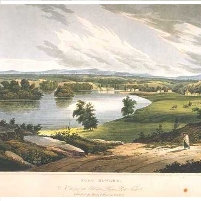EPA to Bury Contaminated Remnant of Colonial Fort
Thursday, August 20, 2009
 Fort Edward, 1825
Fort Edward, 1825
Residents of the town of Fort Edward, in upstate New York, are wondering why the U.S. Environmental Protection Agency allowed its private contractor, General Electric, to dredge a portion of the Hudson River where historical remains were damaged, and will now be disposed of.
The town got its name from the original Fort Edward, one of the largest British military bases in North America established around the time of the French and Indian War in the mid-18th century. What remained of the old fort—two large submerged timbers—were unearthed by the dredging operation, and EPA officials later determined that the dredging had contaminated the artifacts with the carcinogen PCB, forcing their disposal into a landfill.
An EPA spokeswoman said the unearthing of the old fort was partly an accident, as officials were aware of one of the timbers, but not the other that was completely buried in the river bank before the dredging began. The known timber was not supposed to be displaced.
Locals knew where the beams were located, and had voiced concerns at meetings with GE about dredging the area. “Why did we have all those meetings when they’re going to tear into the last remnant of the most important historical structure on the river?” asked David Starbuck, an anthropology professor who has conducted archaeology excavations there since the early 1990s, in the Albany Times-Union.
The dredging operation is being conducted to remove sediments containing PCBs from the river about 40 miles north of Albany.
The fort, built in 1755, once housed more than 15,000 British troops and members of Rogers’ Rangers, an early commando unit. The issue of how to continue the dredging without damaging other historical artifacts is not over. There are reportedly 10 sunken vessels in the way of the project.
-Noel Brinkerhoff
Environmental Protection Agency Says It Will Toss Artifacts from Historic 18th Century Fort into a Landfill (by Adam Brickley, CNS News)
Dredging Damages Old Fort's Remains (by Brian Nearing, Albany Times-Union)
- Top Stories
- Unusual News
- Where is the Money Going?
- Controversies
- U.S. and the World
- Appointments and Resignations
- Latest News
- Musk and Trump Fire Members of Congress
- Trump Calls for Violent Street Demonstrations Against Himself
- Trump Changes Name of Republican Party
- The 2024 Election By the Numbers
- Bashar al-Assad—The Fall of a Rabid AntiSemite






Comments